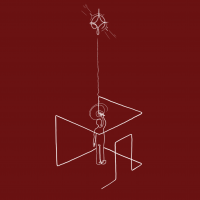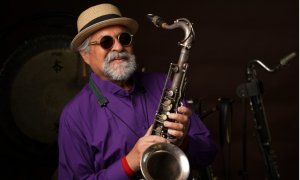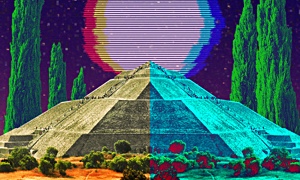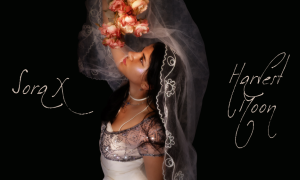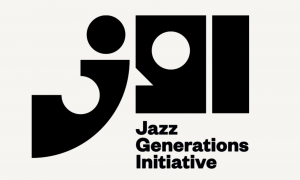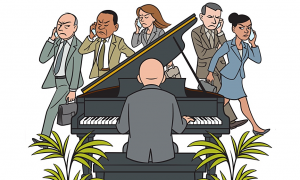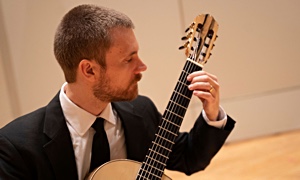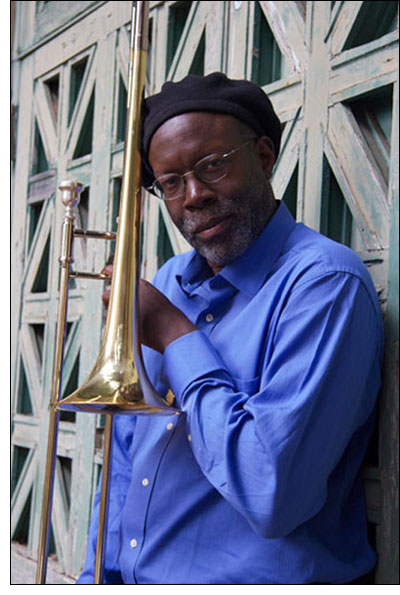
Community plays a powerful role in the creation of a musician; individuals evolve into artists through the impact of the world spinning around them. Musical movements often define a region, leaving their mark upon all its inhabitants. Some areas resonate with a single-minded focus upon one artistic direction while other places overflow with different ideas. For the casual listener, these stylistic trademarks of an area leave a fondness; they stamp the serious musician with an unbreakable imprint. The artist may embrace this connection or walk away from it, but it's always there, informing every artistic choice that comes into their professional life.
Trombonist and composer Wayne Wallace soaked up the massive creativity of the Bay Area lifestyle during his childhood, laying the foundation for the strong artistic output of his adult years. Born in San Francisco on May 29th, 1952, Wallace grew up with music sitting in the background of his life. His parents enjoyed jazz, and as a result, Wallace heard Charlie Parker, Nat King Cole, Clark Terry, Oscar Pettiford, and more during his younger years. Although he studied piano casually, a career in music didn't grab Wallace's attention; in fact, sports took up much more of his time. The trombone grabbed his attention during elementary school though, and he continued playing the instrument in school. San Francisco in the late sixties was a blur of creative excitement, providing a creative springboard for the teenage Wallace. Funk and soul encouraged him to dig deeper into music, as he explored the music of James Brown, Sly And The Family Stone, Blood, Sweat, And Tears, as well as Chicago. During high school, Wallace became acquainted with jazz as a player, and the connection with the recordings of his youth sent him headfirst into the style. He frequented the Fillmore District, sitting in on jam sessions and filling out the trombone section for local big bands. By the age of 17, Wallace had joined the Musician's Union, and worked professionally throughout the city. At that point, his life was firmly connected to the musical scene, as he explored new ideas and styles on a daily basis.
These early experiences secured Wallace's love for performance, and they ensured an open ear to a variety of styles. Both these qualities would benefit Wallace, who would become one of the San Francisco Bay Area's most insightful and diverse artists. In part one of our interview with Wallace, we dig into his childhood experiences with music, his connection with sixties funk, and the jazz scene at the time.
LATIN JAZZ CORNER: You grew up in San Francisco during the fifties and sixties . . .
WAYNE WALLACE: I'm a native San Franciscan—I was born in San Francisco General Hospital, but I grew up in Fillmore District. My mother moved here from Texas and my father moved here from Okalahoma during the 1940s. The first house that I was in was on Steiner Street, then we moved to Bush, up by Masonic. In 1958, we moved out to the Ingleside District out by San Francisco State.
LJC: Was there music in your family?
WW: No, I am the anomaly!
LJC: How did you get interested in playing?
WW: I got interested in music because of my mother and my father. There was an old apartment store here in San Francisco—it was kind of like the K-Mart of its time. I vividly remember going to the store with my mother and my father; they always had these records on sale. I remember that they brought home a couple of records that I still have—one was Louis Jordan & His Tympani Five, and the other one was a record called Jazz Masquerade. Jazz Masqueradewas kind of a bootleg record with Charlie Parker on it. All the musicians were wearing masks on the front cover. Charlie Parker had a pseudonym on it, because he couldn't record on this label. But he got paid for it and they couldn't advertise for it with him. They had bought two Nat King Cole records also. In a backwards kind of way, I started listening to Nelson Riddle at a very early age on those Nat King Cole records; I was influenced by that. I realized there was also another record with Clark Terry, Jimmy Cleveland, and a bunch of other folks, where it's pretty obvious to me now that Billy Strayhorn had done the small band arrangements. I listened to these things over and over again, before I started studying piano in about 1961.
LJC: So jazz was really part of your early childhood . . .
WW: Yes, and it was kind of a serendipitous act. My mother and father just grew up in that era. They came from black communities in the South—the Ellington band and the Basie band played their proms and at their colleges. It was part of the cultural lifestyle. Without them being avid music fans, they passed that on, fortunately for me.
LJC: You started playing piano in the early sixties—was that the beginning of you as a performer?
WW: Not really, my mother just made things available to me. She asked me if I wanted to take piano lessons and I said, “Yes." She bought an old beat-up upright and brought it to the house. I plunked on it. She got me these piano lessons with a German lady named Mrs. Kahn. She introduced me to the Hannon virtuoso book, the John Thompson books, and all the beginning piano books. I just started playing those things. I got up to about the fourth or fifth grade in the John Thompson books. Then it got too hard!
LJC: How did the trombone come into your life?
WW: I distinctly remember in the San Francisco public elementary school system, they would bring instruments around to the schools and ask us if we wanted to play them. So they had a trombone there . . . they actually had everything, like trumpet and saxophone. I looked at all the other ones and they all had too many moving parts. I picked trombone because it looked like it only had one moving part—big mistake!
There were lessons at school and a school band. So I started doing that in fifth grade, sometime in the early sixties.
LJC: Did you have aspirations when you were young to become a performer?
WW: It was just fun. My love at that age was baseball. I'm an avid San Francisco Giants fan—the World Series this year, I've waited all my life for that! I remember where I was in 1962 when Bobby Richardson caught that line drive off Willie McCovey's bat. I remember exactly where I was standing! My mother and father are also responsible for me being a baseball fan—they took me to Seals Stadium and Candlestick Park when it first opened.
LJC: Were you a player?
WW: I played baseball up until high school, and that's when I discovered my love for soccer. Eventually I became a semi-professional soccer player for a little while.
LJC: How did you balance music and sports?
WW: It was easy then. My biggest choice was which sport to drop—I was playing baseball, soccer, and dabbling with being a kicker on my high school football team. At one point, I just said, “O.K., I'm a soccer player. I can't hit a fastball or a curve, I'll leave it alone and just move on.
Music moved to the forefront in junior high school. I got into an all James Brown band. That's all we did was James Brown covers—side one and side two! Lick & Stick side one, Lick & Stick side two, Papa's Got A Brand New Bag side one, Papa's Got A Brand New Bag side two—the whole thing.
It was a funny time for music here in San Francisco. At that time—'67, '68, '69—you had the convergence of the peace & love movement, the Fillmore scene, Santana was happening, and Sly Stone was happening. Johnny Mathis' brother lived down the street from my mother and father's house. David Brown, the bassist, didn't live too far from here. A lot of people from Sly And The Family Stone were here at that time. Leon Patillo had a band called Leon's creation—it was so similar to Sly Stone's band . . . Or you could say Sly Stone's band was so similar to his. But it was Sly's band that broke first. All that was going on.
One of the bands that influenced me the most was a band in 1968 called Granny Goose And The Soul Chips. It was a fabulous band—kind of a James Brown take off. It was mainly people in high school that had put together a soul revue. I saw that and it was a major influence. I thought—"Man, I want to play trombone in a band like that!"
Then you had all the rock bands going on—The Monkees, The Airplane, The Grateful Dead, Quicksilver—any of those bands around that time. A lot of those bands didn't have trombone players in them. Blood, Sweat, And Tears had a trombone, and I thought, “Oh, a place for me." Then of course, Chicago came out.
I got the jazz bug in high school. We had a wonderful teacher there by the name of Sid Walker. He turned us onto Coltrane and Ellington. I became conscious of the people that I had been listening to. He turned me onto that music.
Eventually I migrated to The Boy's Club Band here in San Francisco—it was on Alabama Street at Fat Boy's club. In that band, was Greg Adams, who eventually went onto Tower Of Power. There was another trombonist that impressed me because of his high range, his name was Dave Coddington—a beautiful trombonist. I just knew I wanted to play jazz at that point.
LJC: All these guys were around you, were there opportunities for you to hang out with them, play, and get advice?
WW: Actually no, they were older than me at that point. I met all of those guys later in my career. I was hanging out in the Fillmore at the clubs there. There were jam sessions going on up in the Lower Haight. Bishop Norman Williams was leading sessions at a little club on Haight Street. It was on the Lower Haight, around Steiner and Fillmore.
My introduction to big band was at The Booker T. Washington Center, which was up off of Masonic Street at the time. There was an older jazz trumpet player there that took me under his wing, a really nice cat. He made sure that I knew about the sessions for the big band and he had jam sessions at his house. Benny Harris was still alive at this point; I met Benny Harris and got that information that he was the actual author of “Ornithology." I had a great mentoring is the way that I can describe that time.
I joined the musician's union when I was 17. I joined the Union three or four years after they finally merged the black musician's union with the white musician's union. I missed that tail end of there being a black musician's union. But a lot of those guys who had joined when the two merged ended up being my mentors—Alan Smith, Bennie Figueroa, Vernon Alley, Eddie Alley, all those guys.
Trombonist and composer Wayne Wallace soaked up the massive creativity of the Bay Area lifestyle during his childhood, laying the foundation for the strong artistic output of his adult years. Born in San Francisco on May 29th, 1952, Wallace grew up with music sitting in the background of his life. His parents enjoyed jazz, and as a result, Wallace heard Charlie Parker, Nat King Cole, Clark Terry, Oscar Pettiford, and more during his younger years. Although he studied piano casually, a career in music didn't grab Wallace's attention; in fact, sports took up much more of his time. The trombone grabbed his attention during elementary school though, and he continued playing the instrument in school. San Francisco in the late sixties was a blur of creative excitement, providing a creative springboard for the teenage Wallace. Funk and soul encouraged him to dig deeper into music, as he explored the music of James Brown, Sly And The Family Stone, Blood, Sweat, And Tears, as well as Chicago. During high school, Wallace became acquainted with jazz as a player, and the connection with the recordings of his youth sent him headfirst into the style. He frequented the Fillmore District, sitting in on jam sessions and filling out the trombone section for local big bands. By the age of 17, Wallace had joined the Musician's Union, and worked professionally throughout the city. At that point, his life was firmly connected to the musical scene, as he explored new ideas and styles on a daily basis.
These early experiences secured Wallace's love for performance, and they ensured an open ear to a variety of styles. Both these qualities would benefit Wallace, who would become one of the San Francisco Bay Area's most insightful and diverse artists. In part one of our interview with Wallace, we dig into his childhood experiences with music, his connection with sixties funk, and the jazz scene at the time.
LATIN JAZZ CORNER: You grew up in San Francisco during the fifties and sixties . . .
WAYNE WALLACE: I'm a native San Franciscan—I was born in San Francisco General Hospital, but I grew up in Fillmore District. My mother moved here from Texas and my father moved here from Okalahoma during the 1940s. The first house that I was in was on Steiner Street, then we moved to Bush, up by Masonic. In 1958, we moved out to the Ingleside District out by San Francisco State.
LJC: Was there music in your family?
WW: No, I am the anomaly!
LJC: How did you get interested in playing?
WW: I got interested in music because of my mother and my father. There was an old apartment store here in San Francisco—it was kind of like the K-Mart of its time. I vividly remember going to the store with my mother and my father; they always had these records on sale. I remember that they brought home a couple of records that I still have—one was Louis Jordan & His Tympani Five, and the other one was a record called Jazz Masquerade. Jazz Masqueradewas kind of a bootleg record with Charlie Parker on it. All the musicians were wearing masks on the front cover. Charlie Parker had a pseudonym on it, because he couldn't record on this label. But he got paid for it and they couldn't advertise for it with him. They had bought two Nat King Cole records also. In a backwards kind of way, I started listening to Nelson Riddle at a very early age on those Nat King Cole records; I was influenced by that. I realized there was also another record with Clark Terry, Jimmy Cleveland, and a bunch of other folks, where it's pretty obvious to me now that Billy Strayhorn had done the small band arrangements. I listened to these things over and over again, before I started studying piano in about 1961.
LJC: So jazz was really part of your early childhood . . .
WW: Yes, and it was kind of a serendipitous act. My mother and father just grew up in that era. They came from black communities in the South—the Ellington band and the Basie band played their proms and at their colleges. It was part of the cultural lifestyle. Without them being avid music fans, they passed that on, fortunately for me.
LJC: You started playing piano in the early sixties—was that the beginning of you as a performer?
WW: Not really, my mother just made things available to me. She asked me if I wanted to take piano lessons and I said, “Yes." She bought an old beat-up upright and brought it to the house. I plunked on it. She got me these piano lessons with a German lady named Mrs. Kahn. She introduced me to the Hannon virtuoso book, the John Thompson books, and all the beginning piano books. I just started playing those things. I got up to about the fourth or fifth grade in the John Thompson books. Then it got too hard!
LJC: How did the trombone come into your life?
WW: I distinctly remember in the San Francisco public elementary school system, they would bring instruments around to the schools and ask us if we wanted to play them. So they had a trombone there . . . they actually had everything, like trumpet and saxophone. I looked at all the other ones and they all had too many moving parts. I picked trombone because it looked like it only had one moving part—big mistake!
There were lessons at school and a school band. So I started doing that in fifth grade, sometime in the early sixties.
LJC: Did you have aspirations when you were young to become a performer?
WW: It was just fun. My love at that age was baseball. I'm an avid San Francisco Giants fan—the World Series this year, I've waited all my life for that! I remember where I was in 1962 when Bobby Richardson caught that line drive off Willie McCovey's bat. I remember exactly where I was standing! My mother and father are also responsible for me being a baseball fan—they took me to Seals Stadium and Candlestick Park when it first opened.
LJC: Were you a player?
WW: I played baseball up until high school, and that's when I discovered my love for soccer. Eventually I became a semi-professional soccer player for a little while.
LJC: How did you balance music and sports?
WW: It was easy then. My biggest choice was which sport to drop—I was playing baseball, soccer, and dabbling with being a kicker on my high school football team. At one point, I just said, “O.K., I'm a soccer player. I can't hit a fastball or a curve, I'll leave it alone and just move on.
Music moved to the forefront in junior high school. I got into an all James Brown band. That's all we did was James Brown covers—side one and side two! Lick & Stick side one, Lick & Stick side two, Papa's Got A Brand New Bag side one, Papa's Got A Brand New Bag side two—the whole thing.
It was a funny time for music here in San Francisco. At that time—'67, '68, '69—you had the convergence of the peace & love movement, the Fillmore scene, Santana was happening, and Sly Stone was happening. Johnny Mathis' brother lived down the street from my mother and father's house. David Brown, the bassist, didn't live too far from here. A lot of people from Sly And The Family Stone were here at that time. Leon Patillo had a band called Leon's creation—it was so similar to Sly Stone's band . . . Or you could say Sly Stone's band was so similar to his. But it was Sly's band that broke first. All that was going on.
One of the bands that influenced me the most was a band in 1968 called Granny Goose And The Soul Chips. It was a fabulous band—kind of a James Brown take off. It was mainly people in high school that had put together a soul revue. I saw that and it was a major influence. I thought—"Man, I want to play trombone in a band like that!"
Then you had all the rock bands going on—The Monkees, The Airplane, The Grateful Dead, Quicksilver—any of those bands around that time. A lot of those bands didn't have trombone players in them. Blood, Sweat, And Tears had a trombone, and I thought, “Oh, a place for me." Then of course, Chicago came out.
I got the jazz bug in high school. We had a wonderful teacher there by the name of Sid Walker. He turned us onto Coltrane and Ellington. I became conscious of the people that I had been listening to. He turned me onto that music.
Eventually I migrated to The Boy's Club Band here in San Francisco—it was on Alabama Street at Fat Boy's club. In that band, was Greg Adams, who eventually went onto Tower Of Power. There was another trombonist that impressed me because of his high range, his name was Dave Coddington—a beautiful trombonist. I just knew I wanted to play jazz at that point.
LJC: All these guys were around you, were there opportunities for you to hang out with them, play, and get advice?
WW: Actually no, they were older than me at that point. I met all of those guys later in my career. I was hanging out in the Fillmore at the clubs there. There were jam sessions going on up in the Lower Haight. Bishop Norman Williams was leading sessions at a little club on Haight Street. It was on the Lower Haight, around Steiner and Fillmore.
My introduction to big band was at The Booker T. Washington Center, which was up off of Masonic Street at the time. There was an older jazz trumpet player there that took me under his wing, a really nice cat. He made sure that I knew about the sessions for the big band and he had jam sessions at his house. Benny Harris was still alive at this point; I met Benny Harris and got that information that he was the actual author of “Ornithology." I had a great mentoring is the way that I can describe that time.
I joined the musician's union when I was 17. I joined the Union three or four years after they finally merged the black musician's union with the white musician's union. I missed that tail end of there being a black musician's union. But a lot of those guys who had joined when the two merged ended up being my mentors—Alan Smith, Bennie Figueroa, Vernon Alley, Eddie Alley, all those guys.








